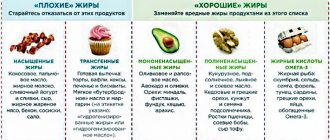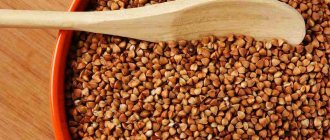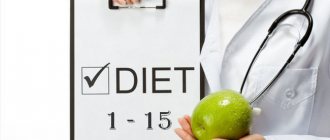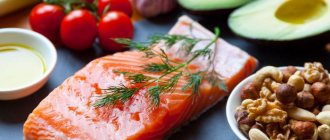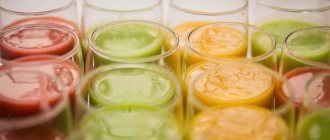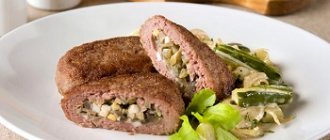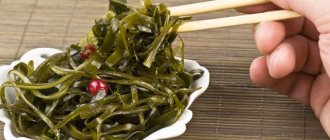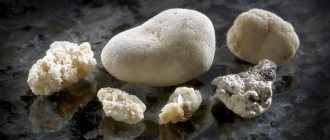What is a balanced diet?
When it comes to balance in the diet, few people understand how it is formed. The meaning of this phrase is the need to correlate replaceable and irreplaceable components in your diet, which ensures proper growth and development of the body, preserves the health given by nature, and the amount of energy consumed and expended is compared in such a way that performance is high. Essential nutrients are substances synthesized by the body in small quantities or not synthesized at all that are necessary for normal functioning. These enter the body exclusively with food. These are 8 essential amino acids, 3 fatty acids and a dozen vitamins (A, group B, K and others), as well as essential mineral salts (calcium, magnesium, phosphorus, potassium and many others). Replaceable components can be produced by the human body, but in this case the work of internal organs and systems will be hampered, compensation mechanisms will be disrupted, which risks leading to negative consequences, and therefore the supply of the same replaceable substances with food is more favorable. Rational and balanced nutrition promotes the normal development of a young body, ensures good health and longevity, increases the body's resistance to adverse environmental factors, and underlies high-quality mental and physical activity.
The ratio between nutrients entering the body is determined by the level of activity performed during a certain period of life:
- for the average knowledge worker - 1: 1: 4;
- for people engaged in light work - 1: 1.2: 4;
- for people engaged in moderate work - 1: 1.2: 4.6;
- for athletes trying to build muscle mass - 1: 0.8: 4;
- for teenagers - 1: 0.9: 4.2;
- for people over 60 years old - 1: 1.1: 4.8.
Of the total amount of proteins, 50-60% should be of animal origin. Vegetable oils make up 20-25% of the total fat, and in some diseases - 30-35%. Of the total amount of carbohydrates, easily digestible carbohydrates (sucrose, fructose, lactose) can account for 20%, starch - 75%, fiber and pectin - 5%. Mineral substances also require a certain ratio in quantity, for example, the recommended combination of calcium and phosphorus is 1:1.5-2.0, and calcium and magnesium - 1:0.6.
A constant or gross violation of such proportions entails a breakdown of enzymatic systems and metabolic processes, and the development of various pathologies in the body. Nutritional balance will be achieved provided that the daily menu includes the entire variety of animal and plant products, fresh vegetables and fruits, food of various culinary preparations that promote saturation without excessive stress on the gastrointestinal tract. Of course, the diet should not include toxic or contaminated foods whose quality is questionable. The diet itself must correspond to the energy needs of the body, that is, contain a sufficient amount of nutrients with a given ratio of proportions.
The presence of a chronic disease in a person makes significant adjustments to the diet. Even if the disease is not related to the gastrointestinal tract, it is necessary to take into account the effect of the food consumed on the entire body and each organ in particular.
Indications
The medical diet has 2 main purposes:
- prevention of excess fat deposition in tissue in the presence of concomitant pathology;
- eliminating the accumulation of excess fatty tissue in the body for any type of obesity .
The medical diet is intended for use in cases of overweight, obesity of I, II, III degrees (the underlying disease) and in the presence of other diseases that require special diets if the patient does not have problems with the digestive tract. The diet can be prescribed before surgical treatment, which cannot be carried out in case of obesity.
What is nutritional therapy?
Therapeutic nutrition is a diet designed in such a way that a complex of foods consumed over a long period of time strengthens the effect of the main treatment and reduces the likelihood of relapses and exacerbations in the chronic course of the disease. The so-called diet therapy takes into account all the nuances of the course of the disease, its clinical manifestations, dynamics, and non-compliance with this in some diseases simply does not allow achieving the desired result in treatment. The effect of diet therapy on the patient’s body is determined by:
- qualitative and quantitative composition of food (proteins, fats, carbohydrates, vitamins, minerals, trace elements, etc.) and its calorie content;
- physical properties - volume, temperature, consistency;
- diet - hours of intake, distribution of food during the day, frequency of meals;
- medicinal properties of some products.
Therapeutic nutrition is based on the principles of so-called sparing of the body, of which there are three types:
- mechanical sparing is mainly two processes in relation to products, their grinding and heat treatment, as a result of which a consistency that is as easy to digest as possible is achieved; helps ease and normalize gastrointestinal function;
- chemical sparing - exclusion from the diet of sour, spicy, salty, fried foods, thereby avoiding the secretory activity of the gastrointestinal tract and the stimulating effect on the body as a whole;
- thermal sparing - exclusion from the diet of strong thermal irritants, namely very cold (less than 15°C) or hot (more than 60°C) food; This eliminates the sap effect of hot water, which weakens gastric motility, or the effect of cold food, which reduces motility and juice secretion.
Medical nutrition certainly contains a strict regime and frequency of portion consumption. For example, increasing the number of meals up to five times means reducing the time between meals to 3-4 hours. Some diets take into account not only the meal schedule, but also the calorie content of each serving. The therapeutic nutrition regimen is based on the following features:
- extremely rarely, almost never, a complete diet that satisfies the patient’s appetite and taste does not meet the requirements of therapeutic measures in the treatment of chronic conditions;
- the amount of calories consumed should correspond to gender, age, nature of the activity performed and general health;
- the diet should ensure that the body receives the full amount of vitamins, minerals and water;
- any diet must provide the body with a sufficient amount of protein, the lower limit of which is usually calculated as 1 gram of protein per 1 kg of human weight;
- the diet of a sick person, no less than a healthy one, requires the supply of plant fiber and leafy vegetables, the processing of which can promote faster absorption, but the component itself must remain unchanged;
- raw vegetables, fruits and herbs should be present in any type of dietary food, even in minimal quantities; under the most stringent restrictions, freshly squeezed juices diluted with water can be an alternative;
- meals within the framework of therapeutic nutrition should be distributed throughout the day, and sometimes even 24 hours, dinner should occur 2-3 hours before bedtime; The diet should be compared with the time of rest, vigorous activity and therapeutic procedures;
- The transition from one mode to another should be carried out gradually.
Table No. 5
Recommendations for product types
Indications:
- chronic hepatitis with a benign and progressive course;
- liver cirrhosis without exacerbation;
- chronic cholecystitis;
- cholelithiasis;
- acute hepatitis and cholecystitis during the recovery period;
- other diseases accompanied by dysfunction of the liver and biliary tract.
Diet: 5 times a day
Duration of appointment: unlimited
Nutrition Features:
Dishes are mostly boiled or baked after pre-cooking. Food is prepared mainly in uncut form. Flour and vegetables for dressing are not fried, but dried.
Table No. 5a
Indications:
- acute hepatitis and cholecystitis;
- exacerbation of chronic hepatitis, cholecystitis, liver cirrhosis.
Diet: 5 times a day
Appointment period: several days
Nutritional features: nutrition is the same as with diet No. 5, but you should eat more protein-containing foods, limit foods containing fats and carbohydrates; dishes that enhance the processes of fermentation and putrefaction in the intestines, strong stimulants of bile secretion and substances that irritate the liver.
Dishes are prepared boiled, pureed, and served warm. Separate baked dishes of meat and fish, pre-boiled, without crust, are allowed.
The influence of certain categories of products on the function of the gastrointestinal tract
The formation of dietary nutrition, despite the fact that it can have an impact on any organ or system in the body, certainly takes into account the functionality of the patient’s gastrointestinal tract. Nutritionists focus on the following properties of food products:
- quickly digestible - milk and dairy products, soft-boiled eggs, fresh fruits and berries;
- slowly digested - fresh bread and bakery products, refractory fats, fried meat, legumes;
- have a strong juice effect - meat, fish, mushrooms and broths made from them, as well as cheese, spices, cabbage, cucumbers, smoked meats;
- have a weak juice effect - milk and dairy products, boiled vegetables and fruits, boiled meat, green peas, butter, fresh cottage cheese, soft-boiled eggs;
- have a laxative effect - prunes, vegetable oil, cold vegetable dishes and juices, sweet drinks, vegetables and fruits, one-day kefir, cold mineral water, wholemeal bread;
- have a binding effect - hot dishes, jelly, rice and semolina porridge, flour dishes, cocoa, coffee, chocolate;
- have a choleretic effect - vegetable oils (especially olive), vegetables rich in plant fiber (in particular tomatoes, radishes, beets);
- cause flatulence - legumes, fresh rye bread, white cabbage, whole milk;
- excite the central nervous system - meat and fish broths, cheese, cocoa, coffee, strong tea, herbs and spices.
Fully or partially limited products
A weight loss diet is based on the complete exclusion from the menu of foods that can increase appetite. The use of extractives and flavorings is prohibited. Extractive substances do not carry any nutritional value, but are quite strong stimulants of the secretion of juices in the digestive system, which has a beneficial effect on the processes of food digestion. However, while taking these substances, there is an increase in appetite, which can have an adverse effect on the weight loss process.
A reduction in the energy value of the diet is achieved through the consumption of easily digestible carbohydrates and fats of plant and animal origin (to a lesser extent). The amount of protein is reduced by eating animal products. Food should be cooked without salt. It is better to replace sugar with sweeteners ( sorbitol , aspartame , stevioside , xylitol , etc.). All smoked foods, pickled foods, and fatty meats are completely prohibited. All pasta and some types of cereals (semolina, rice, beans) are prohibited. Of fruits and berries, restrictions apply only to sweet varieties: dates, watermelons, raisins, grapes.
Table of prohibited products
| Proteins, g | Fats, g | Carbohydrates, g | Calories, kcal | |
Nuts and dried fruits | ||||
| nuts | 15,0 | 40,0 | 20,0 | 500 |
| candied fruit | 2,0 | 1,0 | 71,0 | 301 |
| dried fruits | 2,3 | 0,6 | 68,2 | 286 |
Snacks | ||||
| potato chips | 5,5 | 30,0 | 53,0 | 520 |
| banana chips | 2,3 | 33,6 | 50,7 | 519 |
Cereals and porridges | ||||
| porridge | 3,3 | 1,2 | 22,1 | 102 |
Flour and pasta | ||||
| noodles | 12,0 | 3,7 | 60,1 | 322 |
| spaghetti | 10,4 | 1,1 | 71,5 | 344 |
| pancakes | 6,1 | 12,3 | 26,0 | 233 |
| vareniki | 7,6 | 2,3 | 18,7 | 155 |
| pancakes | 6,3 | 7,3 | 51,4 | 294 |
| dumplings | 11,9 | 12,4 | 29,0 | 275 |
Bakery products | ||||
| baguette | 7,5 | 2,9 | 51,4 | 262 |
| loaf | 7,5 | 2,9 | 50,9 | 264 |
| bagels | 16,0 | 1,0 | 70,0 | 336 |
| buns | 7,2 | 6,2 | 51,0 | 317 |
| pita | 8,1 | 0,7 | 57,1 | 274 |
| pita | 7,4 | 0,8 | 49,9 | 242 |
| bun | 7,6 | 8,8 | 56,4 | 334 |
| Arctic cod | 7,9 | 9,4 | 55,5 | 339 |
| crackers | 11,2 | 1,4 | 72,2 | 331 |
| bread | 7,5 | 2,1 | 46,4 | 227 |
Confectionery | ||||
| baursak | 6,8 | 2,6 | 45,8 | 234 |
| jam | 0,3 | 0,2 | 63,0 | 263 |
| ganache | 4,9 | 34,5 | 52,5 | 542 |
| jam | 0,3 | 0,1 | 56,0 | 238 |
| jelly | 2,7 | 0,0 | 17,9 | 79 |
| marshmallows | 0,8 | 0,0 | 78,5 | 304 |
| candies | 4,3 | 19,8 | 67,5 | 453 |
| Lukma | 2,0 | 2,1 | 75,6 | 380 |
| marzipan | 6,8 | 21,2 | 65,3 | 479 |
| cookie | 7,5 | 11,8 | 74,9 | 417 |
| cake | 3,8 | 22,6 | 47,0 | 397 |
| jam | 0,4 | 0,2 | 58,6 | 233 |
| gingerbread | 5,8 | 6,5 | 71,6 | 364 |
| Sochnik | 10,1 | 8,8 | 40,5 | 274 |
| dough | 7,9 | 1,4 | 50,6 | 234 |
| chuck-chuck | 8,6 | 1,9 | 77,9 | 363 |
Ice cream | ||||
| ice cream | 3,7 | 6,9 | 22,1 | 189 |
Cakes | ||||
| cake | 4,4 | 23,4 | 45,2 | 407 |
Chocolate | ||||
| chocolate | 5,4 | 35,3 | 56,5 | 544 |
Raw materials and seasonings | ||||
| bouillon cube | 2,0 | 2,0 | 4,0 | 40 |
| yeast | 12,7 | 2,7 | 0,0 | 75 |
| honey | 0,8 | 0,0 | 81,5 | 329 |
| sugar | 0,0 | 0,0 | 99,7 | 398 |
| salt | 0,0 | 0,0 | 0,0 | — |
| sumac | 10,0 | 9,0 | 28,0 | 239 |
| fructose | 0,0 | 0,0 | 99,8 | 399 |
Cheeses and cottage cheese | ||||
| cheese | 24,1 | 29,5 | 0,3 | 363 |
Meat products | ||||
| pork | 16,0 | 21,6 | 0,0 | 259 |
| salo | 2,4 | 89,0 | 0,0 | 797 |
| veal | 19,7 | 1,2 | 0,0 | 90 |
| mutton | 15,6 | 16,3 | 0,0 | 209 |
| rabbit | 21,0 | 8,0 | 0,0 | 156 |
| venison | 19,5 | 8,5 | 0,0 | 154 |
| horsemeat | 20,2 | 7,0 | 0,0 | 187 |
| elk meat | 21,4 | 1,7 | 0,0 | 101 |
| yak meat | 20,0 | 3,5 | 0,0 | 112 |
| bacon | 23,0 | 45,0 | 0,0 | 500 |
| ham | 22,6 | 20,9 | 0,0 | 279 |
| steak | 27,8 | 29,6 | 1,7 | 384 |
Sausages | ||||
| boiled sausage | 13,7 | 22,8 | 0,0 | 260 |
| smoked sausage | 28,2 | 27,5 | 0,0 | 360 |
| dry-cured sausage | 24,1 | 38,3 | 1,0 | 455 |
| sausage with/smoked salami | 11,0 | 63,0 | 0,0 | 631 |
| sausages | 10,1 | 31,6 | 1,9 | 332 |
| sausages | 12,3 | 25,3 | 0,0 | 277 |
| pork chops | 10,0 | 33,0 | 0,0 | 337 |
Bird | ||||
| duck | 16,5 | 61,2 | 0,0 | 346 |
| goose | 16,1 | 33,3 | 0,0 | 364 |
Fish and seafood | ||||
| fish | 18,5 | 4,9 | 0,0 | 136 |
Alcoholic drinks | ||||
| absinthe | 0,0 | 0,0 | 8,8 | 171 |
| brandy | 0,0 | 0,0 | 0,5 | 225 |
| bourbon | 0,0 | 0,0 | 0,4 | 235 |
| white wine Muscat | 0,0 | 0,0 | 5,0 | 82 |
| Cahors red wine | 0,0 | 0,0 | 16,0 | 147 |
| whiskey | 0,0 | 0,0 | 0,4 | 235 |
| vodka | 0,0 | 0,0 | 0,1 | 235 |
| grog | 0,0 | 0,0 | 0,0 | 220 |
| gin | 0,0 | 0,0 | 0,0 | 220 |
| cognac | 0,0 | 0,0 | 0,1 | 239 |
| liquor | 0,3 | 1,1 | 17,2 | 242 |
| beer | 0,3 | 0,0 | 4,6 | 42 |
| punch | 0,0 | 0,0 | 30,0 | 260 |
| rum | 0,0 | 0,0 | 0,0 | 220 |
| tequila | 1,4 | 0,3 | 24,0 | 231 |
| chacha | 0,1 | 0,1 | 0,5 | 225 |
| champagne | 0,2 | 0,0 | 5,0 | 88 |
Non-alcoholic drinks | ||||
| cola | 0,0 | 0,0 | 10,4 | 42 |
| coffee | 0,2 | 0,0 | 0,3 | 2 |
| lemonade | 0,0 | 0,0 | 6,4 | 26 |
| Mirinda | 0,0 | 0,0 | 7,5 | 31 |
| Pepsi | 0,0 | 0,0 | 8,7 | 38 |
| sprite | 0,1 | 0,0 | 7,0 | 29 |
| Fanta | 0,0 | 0,0 | 11,7 | 48 |
| green tea | 0,0 | 0,0 | 0,0 | — |
| black tea | 20,0 | 5,1 | 6,9 | 152 |
Juices and compotes | ||||
| compote | 0,5 | 0,0 | 19,5 | 81 |
| juice | 0,3 | 0,1 | 9,2 | 40 |
| * data is per 100 g of product | ||||
Quitting the diet
When the diet is over, another important moment comes - the exit period, which requires no less pronounced efforts than the nutrition system itself. Judging by the reviews, after 7 or 14 days of the diet, it is very difficult to follow any other rules and restrictions. At the end of the course, the body’s metabolism is very slow, and the body is in strict energy saving mode. If you return to your usual diet, the body will quickly gain reserves, because... is in a state of energy and nutritional deficiency. That is why portions need to be increased gradually, from week to week.
It will be more effective if the portions are increased by adding leafy greens and fresh vegetables. Small portions of porridge or meat are psychologically easier to bear if served on a plate filled with fresh cucumbers, herbs, carrot slices, pepper rings, etc. Try to replace unhealthy foods with healthy ones: instead of sweets - prunes, instead of spaghetti and pasta - fresh vegetables as a side dish, dairy products - low-fat. When leaving the diet, to maximize the results, it is important to completely give up fried foods, sweets and fatty foods.
Doctors' diet for 7 days and 14 days, menu (Meal schedule)
The shortest medical diet lasts 7 days. Below will be presented a seven-day fasting diet, the recipe was developed by doctors.
It is recommended to study the menu in advance in order to prepare all the necessary products and prepare yourself mentally for a week of limited nutrition.
The first day
It is a cleansing fast. On this day you can only drink water, the permitted volume is 1.5 liters.
Second day
A little easier than the first one. On this day you can drink skim milk (4 glasses). You are allowed to eat 1 apple at 7 pm.
Day three
Again a fasting day, on which you can only drink water (volume 1.5 liters). This concludes the most difficult part of the diet.
Day four
Cabbage salad with the addition of greens and carrots (volume for the whole day - 1 liter). The salad can be dressed with olive oil.
Day five
The menu for this day duplicates the second day of the diet, on which you can drink only 4 glasses of skim milk per day.
Day six
| Breakfast |
|
| Dinner |
|
| Dinner |
|
Day seven
| Breakfast |
|
| Dinner |
|
| Dinner |
|
Doctors' diet for 14 days
The diet menu completely duplicates the 7-day diet option. The medical diet for 2 weeks is more difficult to tolerate and is recommended for those who have already tried the 7-day diet and tolerated it well. Initially, going straight to the 14-day course without preparation is not recommended. The reviews are very different: in terms of effectiveness - positive, in terms of tolerability - negative.
Doctors' diet: reviews and results
The medical diet is gaining popularity today. On thematic forums you can find menus and results, but they often present embellished results. The presented diet is very complex and requires complete willpower. It will be better if you find like-minded people who can support you every day in difficult times, at the risk of failure. When evaluating reliable reviews, we can conclude that a medical diet for weight loss allows you to get rid of 5-7 kg in 7 days and 14 kg in 14 days.
Photos of results
Reviews of the medical diet for 7 days are mostly positive. On average, 1 kg is lost per day. The number of kilograms lost largely depends on the initial weight: the higher it is, the greater the weight. The diet is not recommended for those who want to get rid of 3-5 kilograms or less. For these cases, there are softer, balanced diets that are safe for health. The effectiveness of the medical diet is proven by the results with photos.
